Abstract
One hundred phenotypic characteristics were determined for 138 clinical and environmental Aeromonas strains. Cluster analysis revealed three major phenons equivalent to the A. hydrophila, A. caviae, and A. sobria groups, each of which contained more than one genospecies and more than one named species. An excellent correlation was found between phenotypic identification and classification based on DNA relatedness. DNA hybridization groups within each of the phenotypic groups were also separable by using a few biochemical characteristics. Key tests were production of acid from or growth on D-sorbitol (which separated DNA hybridization group 3 from groups 1 and 2 within the A. hydrophila phenogroup), growth on citrate (which essentially separated DNA hybridization group 4 from groups 5A and 5B within the A. caviae phenogroup), and growth on DL-lactate (which separated DNA hybridization group 1 from groups 2 and 3 within the A. hydrophila phenogroup as well as group 5A from groups 4 and 5B within the A. caviae phenogroup). All except one strain in the A. sobria phenogroup belonged to DNA hybridization group 8. DNA hybridization groups were not equally distributed among clinical and environmental isolates, suggesting that strains of certain DNA hybridization groups might be less virulent than others.
Full text
PDF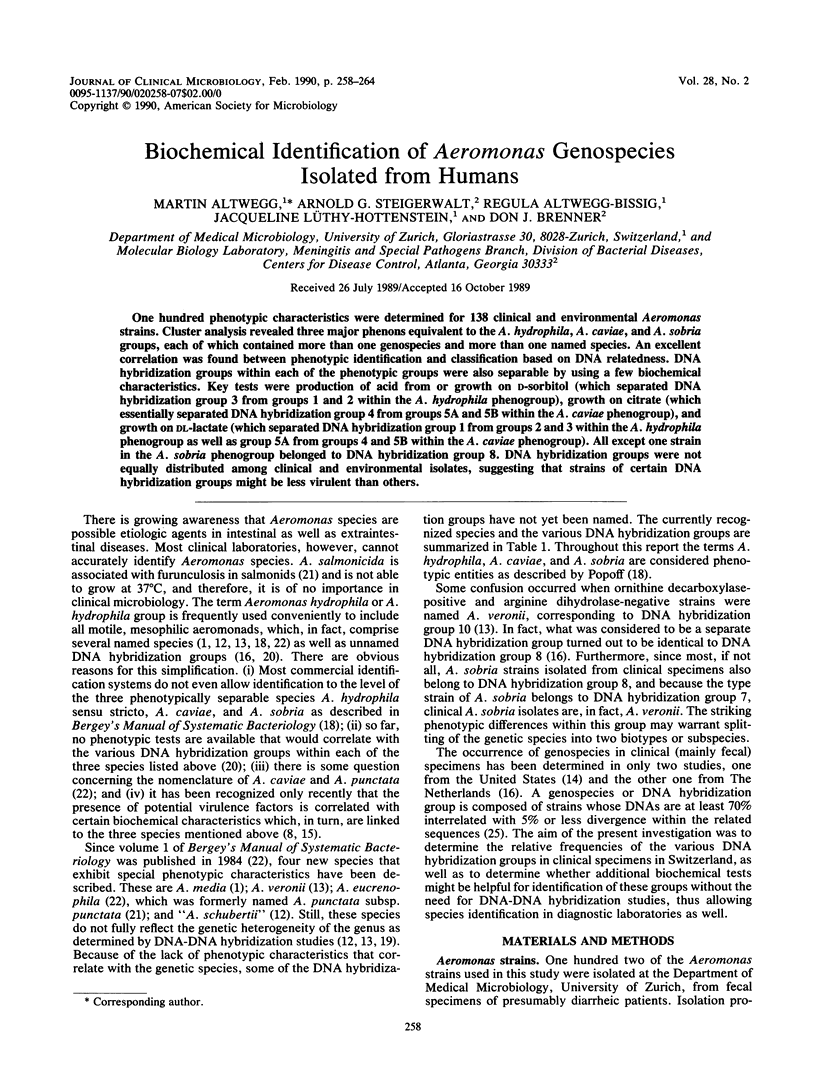
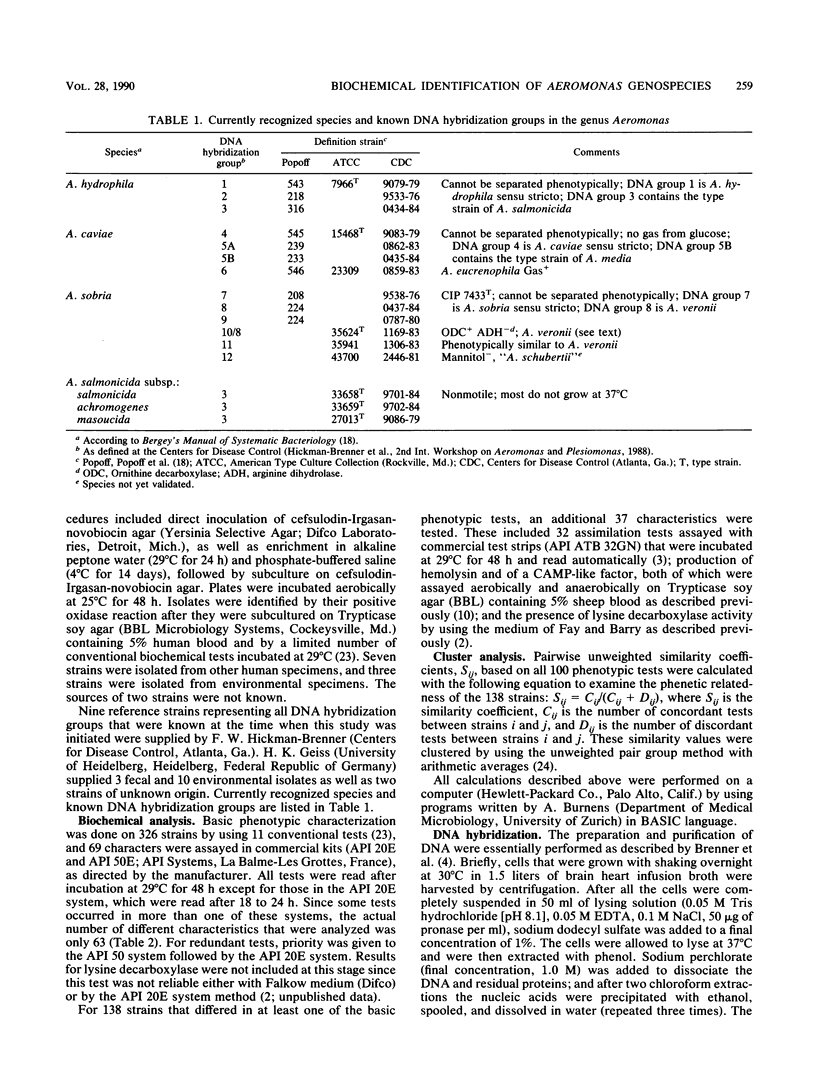
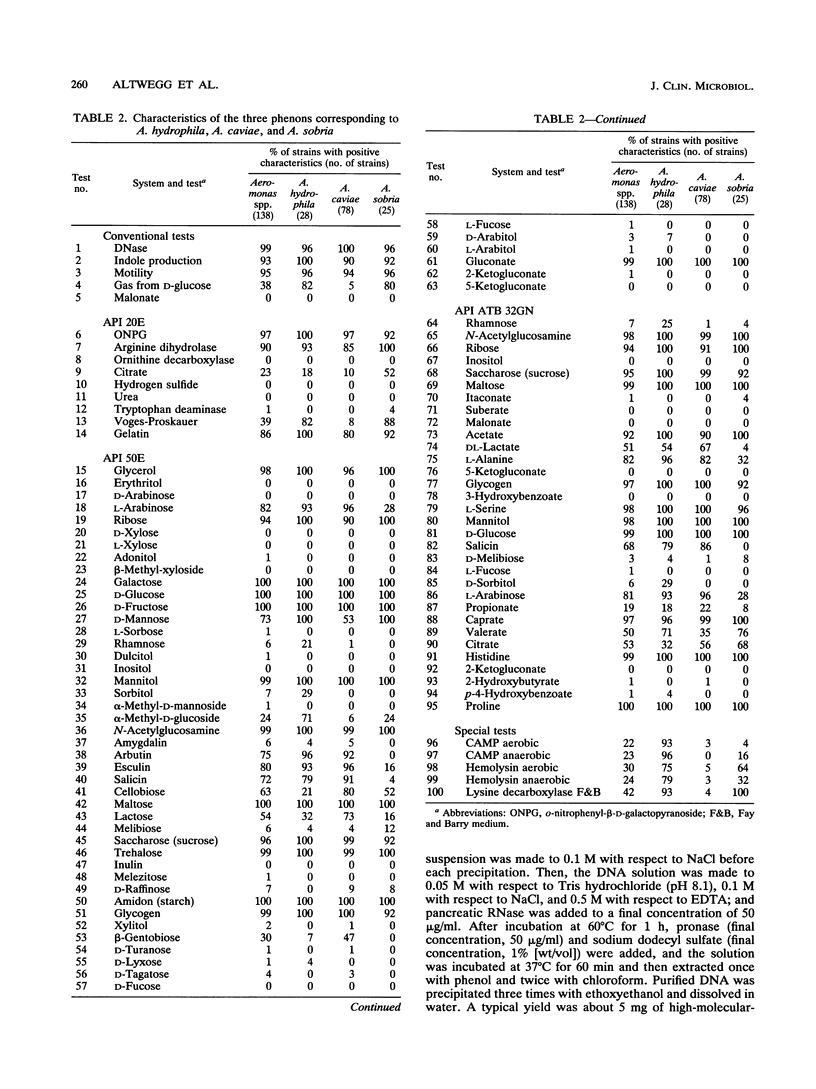
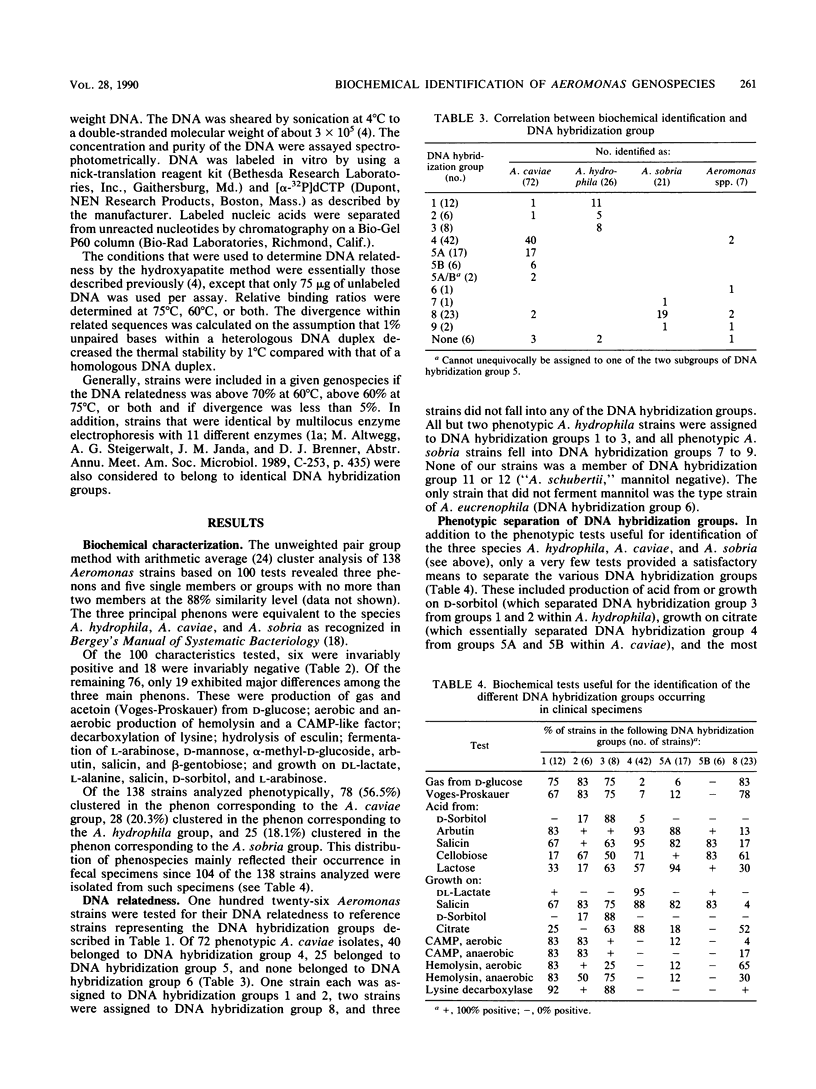
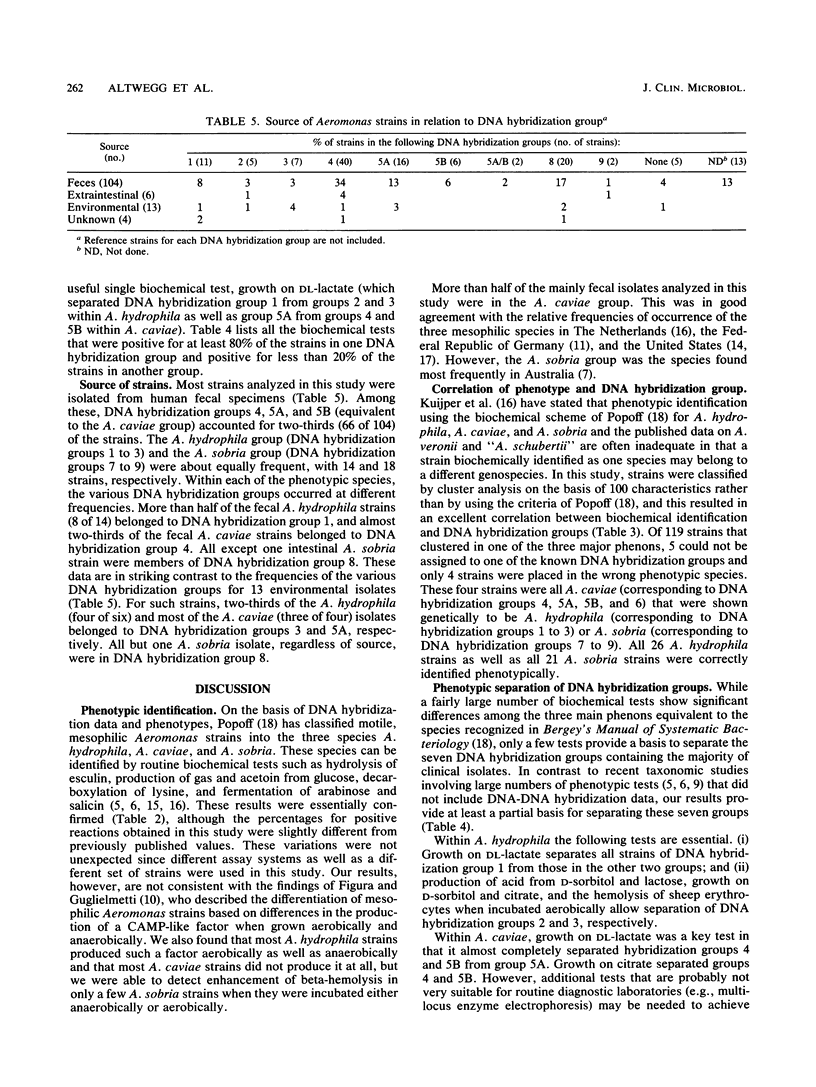
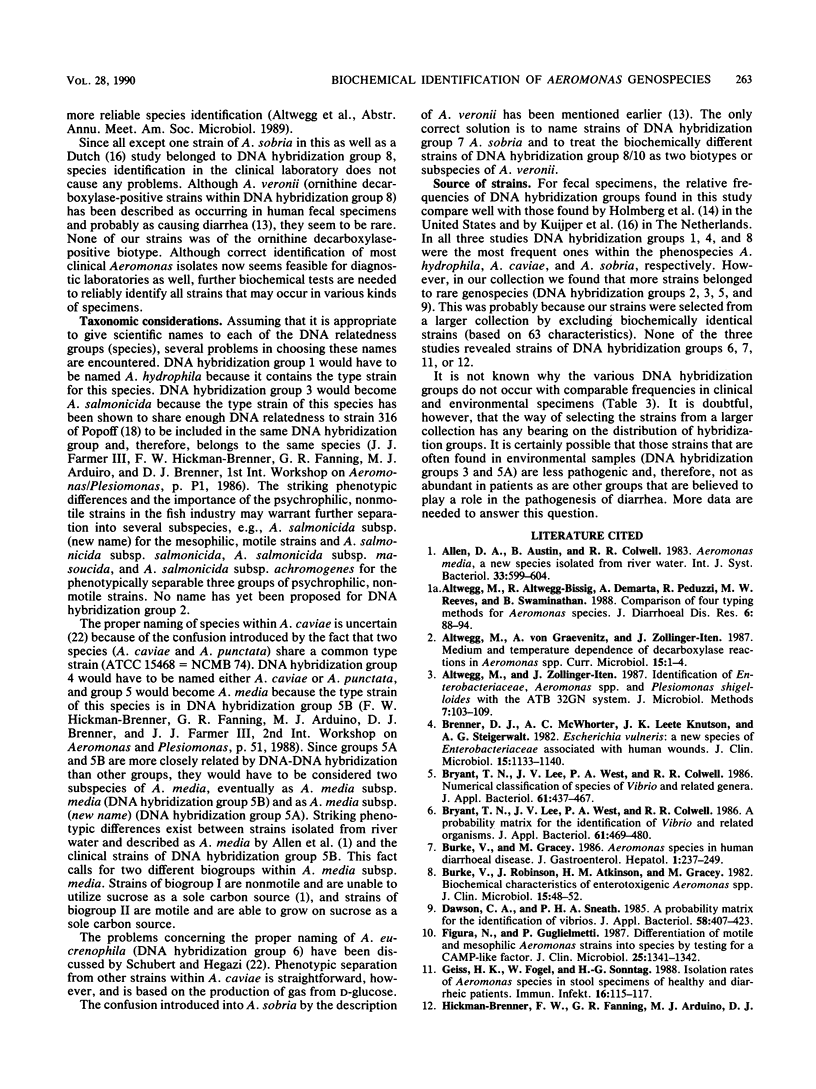
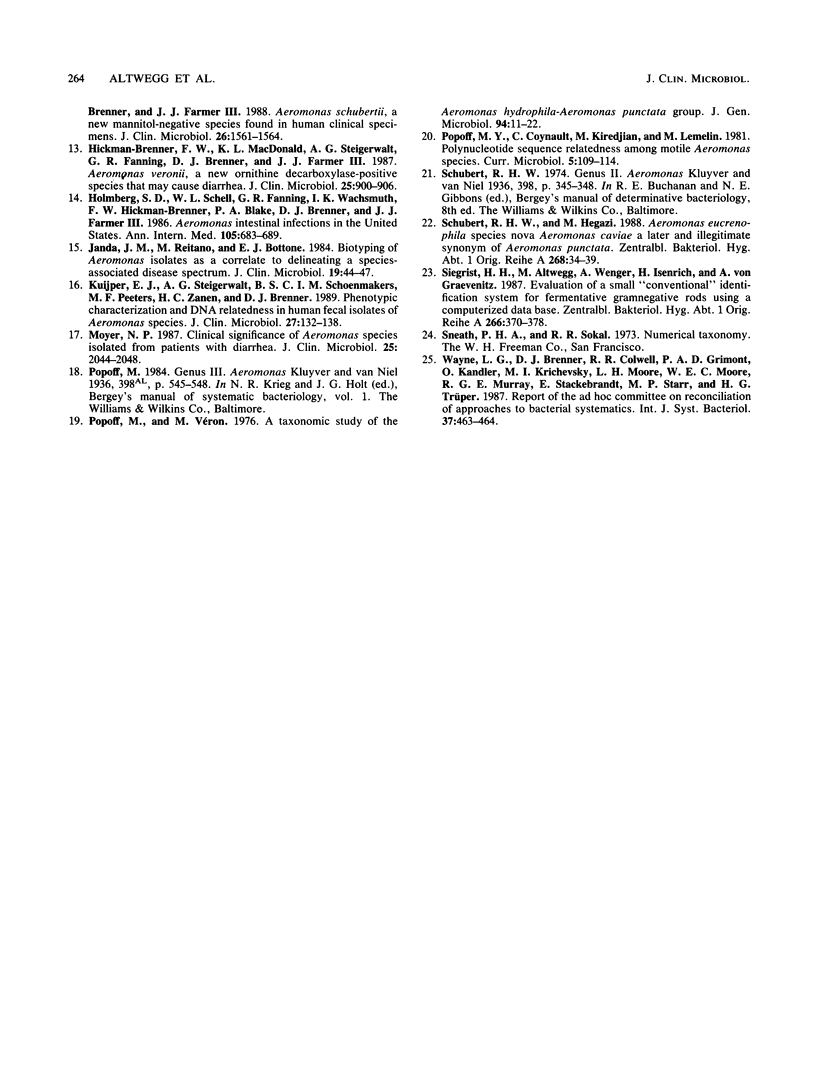
Selected References
These references are in PubMed. This may not be the complete list of references from this article.
- Altwegg M., Altwegg-Bissig R., Demarta A., Peduzzi R., Reeves M. W., Swaminathan B. Comparison of four typing methods for Aeromonas species. J Diarrhoeal Dis Res. 1988 Jun;6(2):88–94. [PubMed] [Google Scholar]
- Brenner D. J., McWhorter A. C., Knutson J. K., Steigerwalt A. G. Escherichia vulneris: a new species of Enterobacteriaceae associated with human wounds. J Clin Microbiol. 1982 Jun;15(6):1133–1140. doi: 10.1128/jcm.15.6.1133-1140.1982. [DOI] [PMC free article] [PubMed] [Google Scholar]
- Bryant T. N., Lee J. V., West P. A., Colwell R. R. A probability matrix for the identification of species of Vibrio and related genera. J Appl Bacteriol. 1986 Nov;61(5):469–480. doi: 10.1111/j.1365-2672.1986.tb04309.x. [DOI] [PubMed] [Google Scholar]
- Bryant T. N., Lee J. V., West P. A., Colwell R. R. Numerical classification of species of Vibrio and related genera. J Appl Bacteriol. 1986 Nov;61(5):437–467. doi: 10.1111/j.1365-2672.1986.tb04308.x. [DOI] [PubMed] [Google Scholar]
- Burke V., Robinson J., Atkinson H. M., Gracey M. Biochemical characteristics of enterotoxigenic Aeromonas spp. J Clin Microbiol. 1982 Jan;15(1):48–52. doi: 10.1128/jcm.15.1.48-52.1982. [DOI] [PMC free article] [PubMed] [Google Scholar]
- Dawson C. A., Sneath P. H. A probability matrix for the identification of vibrios. J Appl Bacteriol. 1985 Apr;58(4):407–423. doi: 10.1111/j.1365-2672.1985.tb01480.x. [DOI] [PubMed] [Google Scholar]
- Figura N., Guglielmetti P. Differentiation of motile and mesophilic Aeromonas strains into species by testing for a CAMP-like factor. J Clin Microbiol. 1987 Jul;25(7):1341–1342. doi: 10.1128/jcm.25.7.1341-1342.1987. [DOI] [PMC free article] [PubMed] [Google Scholar]
- Geiss H. K., Fogel W., Sonntag H. G. Häufigkeit von Aeromonas species im Stuhl von Gesunden und Durchfallkranken. Immun Infekt. 1988 Jun;16(3):115–117. [PubMed] [Google Scholar]
- Hickman-Brenner F. W., Fanning G. R., Arduino M. J., Brenner D. J., Farmer J. J., 3rd Aeromonas schubertii, a new mannitol-negative species found in human clinical specimens. J Clin Microbiol. 1988 Aug;26(8):1561–1564. doi: 10.1128/jcm.26.8.1561-1564.1988. [DOI] [PMC free article] [PubMed] [Google Scholar]
- Hickman-Brenner F. W., MacDonald K. L., Steigerwalt A. G., Fanning G. R., Brenner D. J., Farmer J. J., 3rd Aeromonas veronii, a new ornithine decarboxylase-positive species that may cause diarrhea. J Clin Microbiol. 1987 May;25(5):900–906. doi: 10.1128/jcm.25.5.900-906.1987. [DOI] [PMC free article] [PubMed] [Google Scholar]
- Holmberg S. D., Schell W. L., Fanning G. R., Wachsmuth I. K., Hickman-Brenner F. W., Blake P. A., Brenner D. J., Farmer J. J., 3rd Aeromonas intestinal infections in the United States. Ann Intern Med. 1986 Nov;105(5):683–689. doi: 10.7326/0003-4819-105-5-683. [DOI] [PubMed] [Google Scholar]
- Janda J. M., Reitano M., Bottone E. J. Biotyping of Aeromonas isolates as a correlate to delineating a species-associated disease spectrum. J Clin Microbiol. 1984 Jan;19(1):44–47. doi: 10.1128/jcm.19.1.44-47.1984. [DOI] [PMC free article] [PubMed] [Google Scholar]
- Kuijper E. J., Steigerwalt A. G., Schoenmakers B. S., Peeters M. F., Zanen H. C., Brenner D. J. Phenotypic characterization and DNA relatedness in human fecal isolates of Aeromonas spp. J Clin Microbiol. 1989 Jan;27(1):132–138. doi: 10.1128/jcm.27.1.132-138.1989. [DOI] [PMC free article] [PubMed] [Google Scholar]
- Moyer N. P. Clinical significance of Aeromonas species isolated from patients with diarrhea. J Clin Microbiol. 1987 Nov;25(11):2044–2048. doi: 10.1128/jcm.25.11.2044-2048.1987. [DOI] [PMC free article] [PubMed] [Google Scholar]
- Popoff M., Véron M. A taxonomic study of the Aeromonas hydrophila-Aeromonas punctata group. J Gen Microbiol. 1976 May;94(1):11–22. doi: 10.1099/00221287-94-1-11. [DOI] [PubMed] [Google Scholar]
- Schubert R. H., Hegazi M. Aeromonas eucrenophila species nova Aeromonas caviae a later and illegitimate synonym of Aeromonas punctata. Zentralbl Bakteriol Mikrobiol Hyg A. 1988 Mar;268(1):34–39. doi: 10.1016/s0176-6724(88)80112-3. [DOI] [PubMed] [Google Scholar]
- Siegrist H. H., Altwegg M., Wenger A., Isenrich H., von Graevenitz A. Evaluation of a small "conventional" identification system for fermentative gramnegative rods using a computerized data base. Zentralbl Bakteriol Mikrobiol Hyg A. 1987 Oct;266(3-4):370–378. doi: 10.1016/s0176-6724(87)80217-1. [DOI] [PubMed] [Google Scholar]


